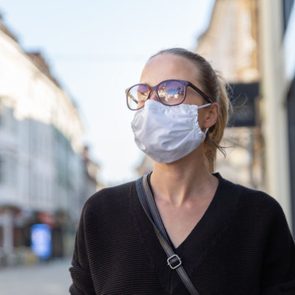How to Tell if Your Symptoms Are Covid-19 or the Flu
Updated: Mar. 03, 2021
Influenza or Covid-19? Both illnesses have very similar symptoms—but there are ways to tell them apart.
Flu season will likely add to the damage Covid-19 continues to inflict. As of late August, the pandemic had killed more than 400,000 people in the United States; the Centers for Disease Control and Prevention (CDC) estimates that influenza kills anywhere from 12,000 to 61,000 people every year. That’s why it’s especially important that you learn the difference between Covid-19 symptoms vs. flu symptoms.
Different viruses cause each illness, but the symptoms (such as fever, cough, fatigue, and body aches) are remarkably similar, making it difficult for patients and doctors alike to know the difference. Being able to tell the two illnesses apart is important because it can impact how they’re managed and because each disease progresses differently, says Natasha Bhuyan, MD, a family practice physician with One Medical in Phoenix. Note, however, that despite what we know about Covid-19, testing is the best, definitive way to distinguish between the two. This is what you need to know about what’s similar and what’s different between symptoms of Covid-19 and the flu.
A pattern of symptoms
While the symptoms of the flu vs. Covid-19 may not be that different, an August 2020 study in Frontiers in Public Health suggests that the order in which symptoms appear may help people tell them apart. The authors analyzed World Health Organization (WHO) data on almost 56,000 Covid-19 patients then, using a model based on the Google algorithm, predicted that the order in which symptoms appeared was slightly different in Covid-19 than with influenza. This was the same regardless of how severe the illnesses were, the study stated.
“The most important part of this work is that there’s an order [to the symptoms],” says study co-author Peter Kuhn, PhD, Dean’s professor of biological sciences and professor of medicine at the University of Southern California. The team is looking for larger sets of data to see if differences in the pattern of symptoms affect how severe the disease is. (Be sure to check out if lockdown has hurt your immune system.)
 Covid-19 symptoms
Covid-19 symptoms
The study found that Covid-19 is more likely to start with a fever (like other coronavirus-related diseases), then progress to a cough, and, finally, nausea/vomiting and diarrhea. The researchers focused on these four symptoms because they are easier to measure, although they did additional analyses on sore throat, body aches, and headache, which people experience as symptoms of Covid-19 and the flu. Not everyone will have all of the following symptoms in this order or at all.
Fever
The first symptom to appear is also the most common symptom among Covid-19 patients, reported by 87.9 percent of patients in the WHO sample. It may start as a low-grade fever (beginning at 100.4 degrees Fahrenheit) then get worse over time, or it can come and go. People who have fever from Covid-19 or other illnesses will often have chills, as well.
Cough
In Kuhn’s study, cough was usually the second symptom to appear and, according to WHO data, it’s the second most common symptom, affecting more than two-thirds (67.7 percent) of that sample. Covid-19 coughs tend to be dry.
Sore throat, body aches, and headache
In the Frontiers study, these symptoms were the most likely to occur next, although they were much less frequent than the first two. In the WHO report, about 14 percent of Covid-19 patients reported each of these symptoms.
Nausea and vomiting
Not that many Covid-19 patients experience nausea and vomiting, but if the symptoms do happen, the study researchers found they usually appeared after the fever and cough—and before diarrhea. An April 2020 study in the American Journal of Gastroenterology found that people with digestive symptoms (not just nausea, vomiting, and diarrhea but also lack of appetite and abdominal pain) were common and became worse with more severe disease.
Diarrhea
Another less common symptom of Covid-19, diarrhea tended to appear last. Diarrhea as a symptom is a bit concerning for infectious disease experts: People with Middle East Respiratory Syndrome (MERS)—which originated in Saudi Arabia in 2012—who developed diarrhea as the first symptom seemed to develop a more severe form of the disease. But Kuhn cautions that no one yet knows if this is the case with Covid-19.
Loss of taste and smell
The study did not look specifically at this symptom but, according to Dr. Bhuyan, some 65 to 80 percent of patients with Covid-19 will lose their sense of taste or smell. This is unlikely to occur with the flu, although it can happen with other viruses, she adds. This is what it’s like to lose your sense of taste and smell due to Covid-19.
Flu symptoms
The Frontiers study authors noted that the pattern of symptoms for influenza was the same as that for Covid-19 with one important exception: The order of the first two symptoms to appear was reversed. A cough tends to hit people with the flu first, followed by a fever. “Influenza starts off with a cough on average, followed by fever, followed by gastrointestinal symptoms,” says Dr. Kuhn.
Cough
Flu symptoms, including a cough, tend to come on more suddenly typically within one to four days of being infected, says Dr. Bhuyan. With Covid-19, cough and other symptoms appear two to 14 days after being infected.
Fever
With the flu, fever can go as high as 103 or 104 degrees Fahrenheit; it will usually go away in three to seven days, but the cough can last for more than two weeks, says the CDC. A headache and sore throat may come on about the same time, reports the study. Also, headaches are more common with influenza than Covid-19.
Nausea, vomiting and diarrhea
Children are more likely than adults to have nausea, vomiting, or diarrhea from the flu, says the CDC.
Runny nose and nasal congestion
Both of these symptoms are very unlikely with Covid-19 but can be common with influenza, says Dr. Bhuyan. You’re also more likely to see sneezing with the flu than Covid-19.
How to prevent the flu
First, get a flu shot. Not only can it prevent many cases of the flu, but it can also reduce the severity of the disease if you do get it. “It’s as important as ever to get the influenza vaccination so you reduce the risk of getting serious influenza infection,” says Michael Matthay, MD, professor of medicine and associate director of critical care medicine at the University of California, San Francisco. “In my experience, patients who’ve had influenza who’ve died almost always are the ones who do not get vaccines.” The CDC recommends everyone over the age of six months get a flu vaccine.
Even if you got a flu shot last year, you need another one this year as the virus strains vary from season to season. Last year’s shot may not protect against this year’s strains. And get it sooner rather than later. The CDC recommends getting the vaccine by the end of October. “There’s no point waiting till late November or December,” says Dr. Matthay.
Higher demand for vaccines
Pharmacies are expecting the demand for flu, pneumonia, and other immunizations to be as much as 30 to 50 percent higher this year than last, says Alex Brown, a spokesperson for Walgreens which, this year, is stocking more vaccines and is also doing clinics at community centers and churches. (Learn more about the best time to get a flu shot.)
The flu vaccine may provide added protection
A June 2020 study (still under review) found that Covid-19 patients who had received a flu vaccine were 8 percent less likely to end up in intensive care than people who had not gotten a vaccine. They were also 18 percent less likely to need a ventilator and 17 percent less likely to die. Why? By prepping the immune system to fight the flu, some researchers hypothesize, the vaccine may prime your immunity to protect against Covid-19 as well.
Another important note on vaccines: Having a flu vaccine shouldn’t affect how safe or effective a Covid-19 vaccine is when it’s available, says Dr. Bhuyan.
How to prevent Covid-19
There’s no vaccine for Covid-19 yet so the best way to prevent it is to wear a mask, keep your distance from other people and wash your hands frequently (preferably with soap and water). In fact, all of these measures provide a triple advantage, says Dr. Matthay. “It will reduce Covid-19 spread, reduce the chances of influenza transmission, and reduce the risk of the common cold,” he explains. If you’re sick, stay home. “This year, it’s more critical that anyone with symptoms stay at home to prevent further spread,” says Dr. Bhuyan.
What to do if you have symptoms
If you have symptoms that feel like influenza or Covid-19, call your doctor so you can be evaluated, advises Dr. Matthay. He or she may order a test for Covid-19, the flu, or both, which is the only way to know for sure if you are infected.
There aren’t many treatments for either illness but doctors do have a few options in their arsenal. If taken within two to three days of flu symptoms, Tamiflu can shorten the length of the sickness, says Dr. Matthay. It can be taken with milder symptoms. For Covid-19, a few promising drugs (the anti-viral remdesivir is one for severe disease only) may decrease the severity of the disease and lower the chances of dying.



















